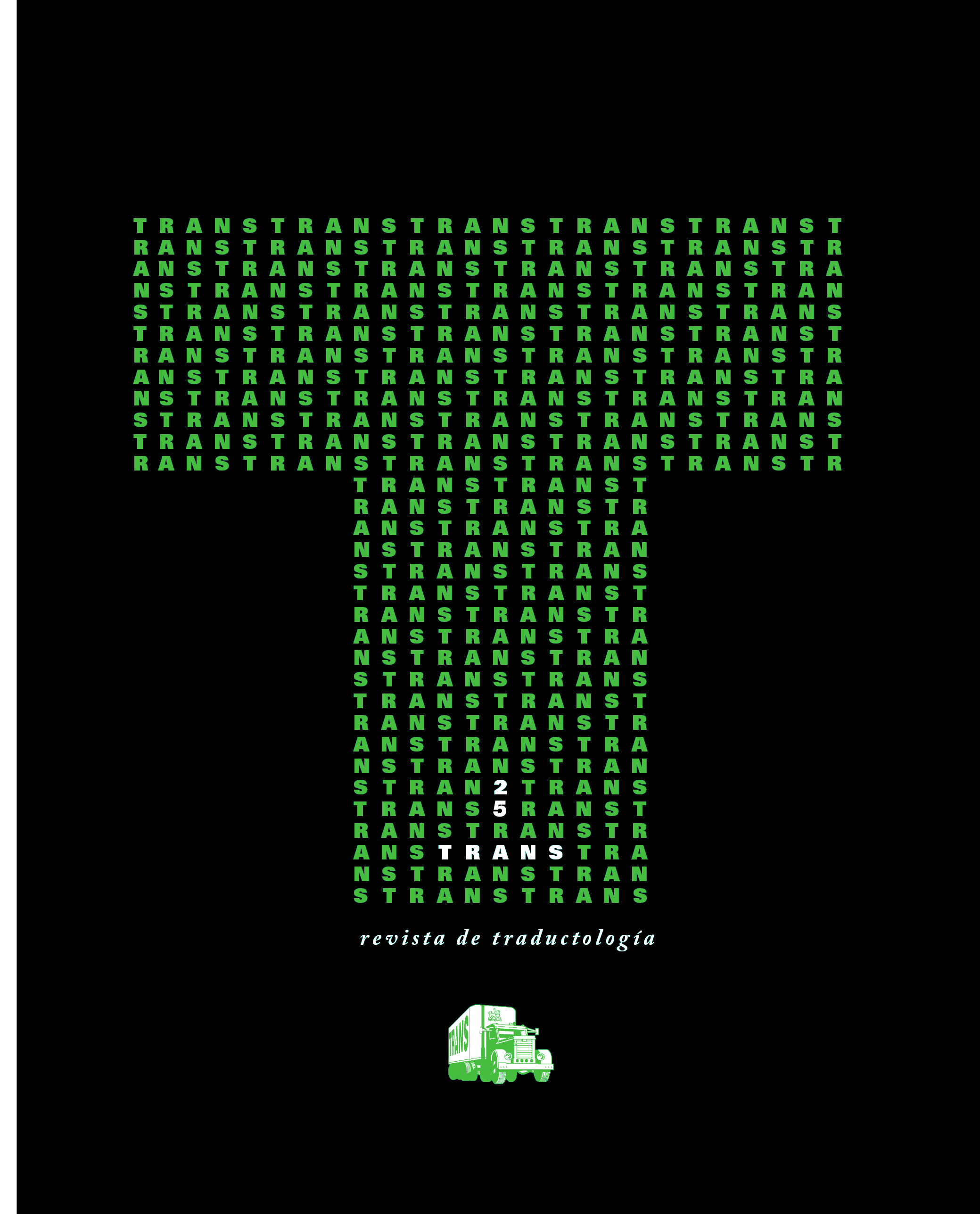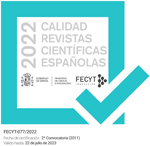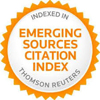«Como si sus ojos fueran soles»: la marcación de la metáfora en la audiodescripción de arte para personas ciegas y con baja visión
DOI:
https://doi.org/10.24310/TRANS.2021.v1i25.12380Palabras clave:
Audiodescripción, Museología accesible, Arte contemporáneo, Metáfora deliberada, marcadores metafóricosResumen
Cada vez más museos utilizan la audiodescripción para facilitar el acceso a los visitantes ciegos y con baja visión. Existen varias herramientas para reformular las imágenes representadas en el arte y traducirlas a la palabra. Este artículo destaca la metáfora deliberada, que el audiodescriptor realiza de forma consciente, comparando lo visual desconocido con la experiencia conocida, normalmente con un «marcador» que llama la atención del receptor, como por ejemplo como o parecido a, que ayudan a los visitantes ciegos y con baja visión a crearse una imagen mental mediante su conocimiento del mundo.
Descargas
Métricas
Publicación Facts
Perfil de revisores N/D
Información adicional autores
Indexado: {$indexList}
-
Indexado en
- Sociedad Académica/Grupo
- N/D
- Editora:
- Universidad de Málaga
Citas
Cameron, Lynne (2003): Metaphor in educational discourse, Londres y Nueva York: Continuum.
Cameron, Lynne & Alice Deignan (1998): «Metaphor signalling devices in talk: Tuning intersubjectivity», Actas del BAAL, septiembre de 1998, Mánchester: Universidad de Mánchester, 10-12.
Cameron, Lynne & Alice Deignan (2003): «Combining Large and Small Corpora to Investigate Tuning Devices Around Metaphor in Spoken Discourse», Metaphor and Symbol, 18/3, 149-160.
Charteris-Black, Jonathan (2012): «Forensic deliberations on purposeful metaphor», Metaphor and the Social World, 2/1, 1-12.
Charteris-Black, Jonathan & Andreas Musolff (2003) «‘Battered hero’ or ‘innocent victim’? A comparative study of metaphors for euro trading in British and German financial reporting», English for Specific Purpose, 22, 153-176.
Deignan, Alice (2011): «Deliberateness is not unique to metaphor. A response to Gibbs», Metaphor and the Social World, 1/1, 57-60.
Edo, Miquel (2018): «Hermenéutica de la audiodescripción museística ante las vanguardias históricas: reticencias hacia el antifigurativismo y potenciación de la polisemia», Arte, Individuo y Sociedad, 30/2, 415-430.
Gibbs, Raymond W. (2008): «Mind & Language», en Raymond W. Gibbs (ed.), The Cambridge Handbook of Metaphor and Thought, Nueva York: Cambridge University Press, 434-458.
Gibbs, Raymond W. (2011): «Are deliberate metaphors really deliberate? A question of human consciousness and action», Metaphor and the Social World, 1/1, 26-52.
Gibbs, Raymond W. (2015): «Do pragmatic signals affect conventional metaphor understanding? A failed test of deliberate metaphor theory», Journal of Pragmatics, 90, 77-87.
Goatly, Andrew (1997): The language of metaphors, Londres y Nueva York: Routledge, 66-77.
Goddard, Cliff (2004): «The ethnopragmatics and semantics of ‘active metaphors’», Journal of Pragmatics, 36, 1211-1230.
Jakobson, Roman (1959): «On linguistic aspects of translation”, en R. A. Brower, (ed.), On Translation, Harvard: Harvard University Press.
Luque Colmenero, María Olalla (2012): «De la metáfora visual a la metáfora lingüística en la audiodescripción», en Eduardo Salas (ed.), Arte y Significación, hacia una semiótica de la interpretación artística, Granada: Zumaya, 346-357.
Luque Colmenero, María Olalla y Silvia Soler (2020): «Metaphor as Creativity in Audio Descriptive Tours for Art Museums: From Description to Practice», Journal of Audiovisual Translation, 3/1, 64–78.
Miller, Anne (1993): «Images and models, similes and metaphors”, en Anthony Ortony (ed.), Metaphor and thought, Cambridge: Cambridge University Press, 357-400.
Miller, Steven y Marcel Fredericks (1990): «Perceptions of the crisis in American public education: the relationship of metaphors to ideology», Metaphor and Symbolic Activity, 5/2, 67-81.
Müller, Cornelia (2016): «Why mixed metaphors make sense”, en Raymond W. Gibbs (ed.), Mixing metaphor, Ámsterdam: John Benjamins, 31-56.
Ortony, Anthony (1993): Metaphor and Thought, Cambridge: Cambridge University Press.
Reijnierse, Gudrun (2017): The value of deliberate metaphor, Amsterdam Center for Language and Communication (ACLC), tesis doctoral inédita.
Reijnierse, Gudrun, Christian Burgers, Tina Krennmayr, y Gerard Steen (2018): «Metaphor in communication: The distribution of potentially deliberate metaphor across register and word class», Corpora, 14:3.
Reviers, Nina (2016): «Audio description services in Europe: An update», The Journal of Specialised Translation, 26, 232-247.
RNIB y Vocal Eyes (2003): The Talking Images Guide. Museumss, galleries and heritage site: improving access for blind and partially sighted people, Londres: RNIB.
Roncero, Carlos, Roberto de Almeida, Deborah Martin y Marco de Caro (2016): «Aptness predicts metaphor preference in the lab and on the internet», Metaphor and Symbol, 31/1, 31-46.
Salzhauer Axel, Elizabeth y Nina Sobol (2003): «AEB’s Guidelines for Verbal Description», en Salzhauer Axel, Elizabeth y Sobol, Nina (eds.), Art Beyond Sight: A resource guide to art, creativity, and visual impairment, Nueva York: AFB Press, 229-237.
Semino, Elena (2002): «A cognitive stylistic approach to mind style in narrative fiction», en Elena Semino y Jonathan Culpeper (eds.), Cognitive stylistics: Language and cognition in text analysis. Ámsterdam y Filadelfia: John Benjamins, 95-122.
Semino, Elena (2008): Metaphor in Discourse, Cambridge: Cambridge University Press.
Semino, Elena (2017): «Corpus Linguistics and Metaphor», en Dancygier, Barbara (ed.), The Cambridge Handbook of Cognitive Linguistics, Cambridge: Cambridge University Press, 463-476.
Snyder, Joel (2010): Guidelines for Audio Description Standards. American Council of the Blind. Versión electrónica: <http://www.acb.org/adp/about.html>.
Soler, Silvia (2013): La traducción accesible en el espacio multimodal museográfico, Córdoba: Universidad de Córdoba, tesis doctoral inedita.
Soler, Silvia y María Olalla Luque Colmenero (2018): «Paintings to my Ears: A Cognitive Corpus-based Approach to the Study of Audio Description in Art Museums», Linguistica Antverpiensia New Series – Themes in Translation Studies, 17, 140-156.
Spinzi, Cinzia G. (2020): «A cross-cultural study of figurative language in museum audio descriptions. Implications for translation», Lingue e Linguaggi, 33, 303-316.
Steen, Gerard (2008): «The paradox of metaphor: Why we need a three-dimensional model of metaphor», Metaphor and Symbol, 23/4, 213-41.
Steen, Gerard (2011): «From three dimensions to five steps: the value of deliberate metaphor», Metaphorik.de, 21, 83-110.
Steen, Gerard, Aletta Dorst, Berenicke Herrman, Anna Kaal, Tina Krennmayr y Pasma Trijntje (2010): A Method for Linguistic Metaphor Idenitfication, Ámsterdam: John Benjamins.
Steen, Gerard. (2015): «Developing, testing and interpreting Deliberate Metaphor Theory», Journal of Pragmatics, 90, 67-72.
Steen, Gerard. (2016): «Mixed metaphor is a question of deliberateness», en Gibbs, Raymond (ed.) 2016. Mixing metaphor, Ámsterdam: John Benjamins, 113-132.
Walczak Agnieska y Louise Fryer (2017): «Creative description: The impact of audio description style on presence in visually impaired audiences», British Journal of Visual Impairment, 35/1, 6-17.
Wallington, Alan Barnden, John Ferguson, F. Joel y Sheila Glasbey (2003): Metaphoricity Signals: A Corpus-Based Investigation, Birmingham: The University of Birmingham.
Xu, Cihua, Chunrui Zhang y Yu Zhang (2016): «Enlarging the scope of metaphor studies», Intercultural Pragmatics, 13/3, 439-447.
Publicado
Cómo citar
Número
Sección
Licencia
Todos los contenidos publicados en TRANS. Revista de Traductología están sujetos a la licencia Creative Commons Reconocimento-NoComercia-Compartirigual 4.0 cuyo texto completo puede consultar en <http://creativecommons.org/licenses/by-nc-sa/4.0>
Se pueden copiar, usar, difundir, transmitir y exponer públicamente, siempre que:
- Se cite la autoría y la fuente original de su publicación (revista, editorial y URL de la obra).
- No se usen para fines comerciales.
- Se mencione la existencia y especificaciones de esta licencia de uso.
- Compartir Igual — Si remezcla, transforma o construye sobre el material, debe distribuir sus contribuciones bajo la misma licencia que el original.
Los derechos de autor son de dos clases: morales y patrimoniales. Los derechos morales son prerrogativas perpetuas, irrenunciables, intransferibles, inalienables, inembargables e imprescriptibles. De acuerdo con la legislación de derechos de autor, TRANS. Revista de Traductología reconoce y respeta el derecho moral de los autores/as, así como la titularidad del derecho patrimonial, el cual será cedido a la Universidad de Málaga para su difusión en acceso abierto. Los derechos patrimoniales, se refieren a los beneficios que se obtienen por el uso o divulgación de las obras. TRANS. Revista de Traductología se publica en open access y queda autorizada en exclusiva para realizar u autorizar por cualquier medio el uso, distribución, divulgación, reproducción, adaptación, traducción o transformación de la obra.
Es responsabilidad de los autores/as obtener los permisos necesarios de las imágenes que están sujetas a derechos de autor.
Los autores/as cuyas contribuciones sean aceptadas para su publicación en esta revista conservarán el derecho no exclusivo de utilizar sus
contribuciones con fines académicos, de investigación y educativos, incluyendo el auto-archivo o depósito en repositorios de acceso abierto de cualquier tipo.













21.png)
